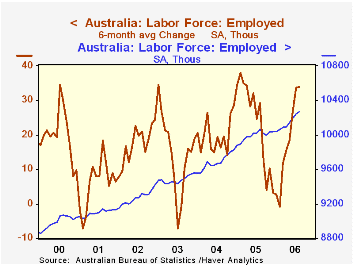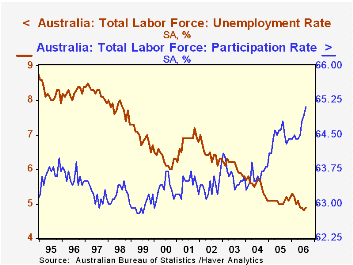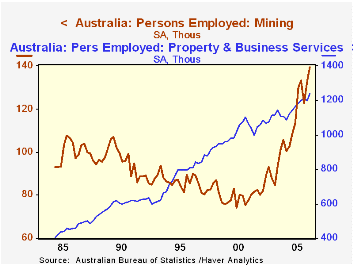 Global| Sep 14 2006
Global| Sep 14 2006Labor Force and Employment Gains Strong in Australia; Unemployment Hovers Near Record Low
Summary
Employment in Australia rose 23,400 in August from July and has increased every month for the last ten. The year-on-year growth is just 2%, but the 10-month advance has occurred at a 3.2% annualized pace, similar to the 2005 [...]

Employment in Australia rose 23,400 in August from July and has increased every month for the last ten. The year-on-year growth is just 2%, but the 10-month advance has occurred at a 3.2% annualized pace, similar to the 2005 performance.
This employment growth is strong enough to absorb sizable increases in labor force participation and still set record low unemployment rates. Unemployment stood at 4.9% of the labor force in August after touching 4.8% in July; until last August, it had never been as low as 5.0%. The rise in the participation rate includes an upturn among male workers since August 2004 after a secular decline that extends back almost continuously to the beginning of the data series in 1978. The participation rate for women continues to trend gradually higher.
These broad labor force aggregates for Australia were published a week ago. Today, September 14, the Australian Bureau of Statistics published greater detail, including "quarterly" industry data. These industry data depart from the common use of the term quarterly; they are not averages or totals but figures that are simply collected only once a quarter, in the mid-month. Thus are "third quarter" readings already available before the actual end of the period. And in our table below, we show the whole array of data with their mid-month of quarter values to facilitate comparison.
As in many "industrial" countries, Australia's manufacturing sector employment is lagging. However, the latest value, 1,054 persons, is ahead of the year-ago level by 13,000, marking the first year-on-year increase in six quarters. The mining sector seems small with only 139,000 employed in August, but it has been a source of growth particularly in metal ores. We mentioned this general characteristic of the Australian economy a couple of weeks ago (September 1) regarding movements in commodity prices there. Construction is growing vigorously, along with several service industries, especially property & business services and health & community services. Not shown in our table is a spurt in government employment, up 35,700 in the latest quarter, but this reflects temporary hiring for the 2006 Australian census. It will be important to check on Australian labor market conditions after the census has been taken and those temporary employees finish their assignments. ABS suggests that they have not inflated employment totals because many have other jobs already. Stay tuned to see how that plays out.
| Australia Labor Force* | Q3 2006 (Aug) | Q2 2006 (May) | Q3 2005 (Aug) | 2005 | 2004 | 2003 |
|---|---|---|---|---|---|---|
| Total Employment (000s) | 10,265 | 10,143 | 10,067 | 9,987 | 9,677 | 9,481 |
| Unemployment (000s) | 524 | 523 | 532 | 537 | 567 | 611 |
| Unemployment Rate (%) | 4.9 | 4.9 | 5.0 | 5.1 | 5.5 | 6.1 |
| Participation Rate (%) | 65.1 | 64.5 | 64.8 | 64.4 | 63.6 | 63.6 |
| Select Industries (000s) | ||||||
| Mining | 139 | 133 | 130 | 121 | 103 | 90 |
| Manufacturing | 1,054 | 1,060 | 1,041 | 1,070 | 1,089 | 1,082 |
| Construction | 899 | 888 | 870 | 867 | 802 | 755 |
| Property & Business Services | 1,233 | 1,196 | 1,197 | 1,171 | 1,108 | 1,112 |
| Health & Community Services | 1,072 | 1,089 | 1,023 | 1,013 | 981 | 932 |
Carol Stone, CBE
AuthorMore in Author Profile »Carol Stone, CBE came to Haver Analytics in 2003 following more than 35 years as a financial market economist at major Wall Street financial institutions, most especially Merrill Lynch and Nomura Securities. She had broad experience in analysis and forecasting of flow-of-funds accounts, the federal budget and Federal Reserve operations. At Nomura Securities, among other duties, she developed various indicator forecasting tools and edited a daily global publication produced in London and New York for readers in Tokyo. At Haver Analytics, Carol was a member of the Research Department, aiding database managers with research and documentation efforts, as well as posting commentary on select economic reports. In addition, she conducted Ways-of-the-World, a blog on economic issues for an Episcopal-Church-affiliated website, The Geranium Farm. During her career, Carol served as an officer of the Money Marketeers and the Downtown Economists Club. She had a PhD from NYU's Stern School of Business. She lived in Brooklyn, New York, and had a weekend home on Long Island.





